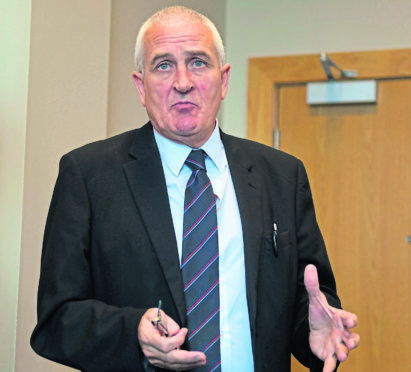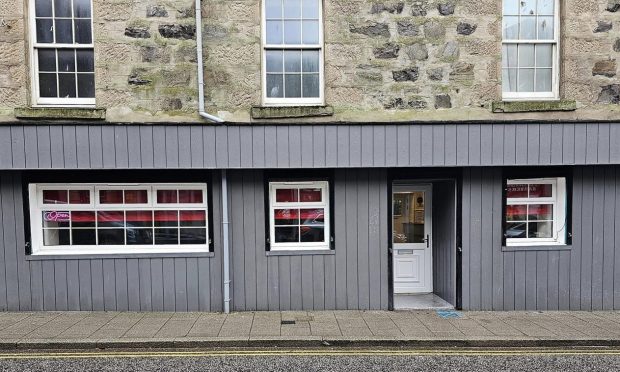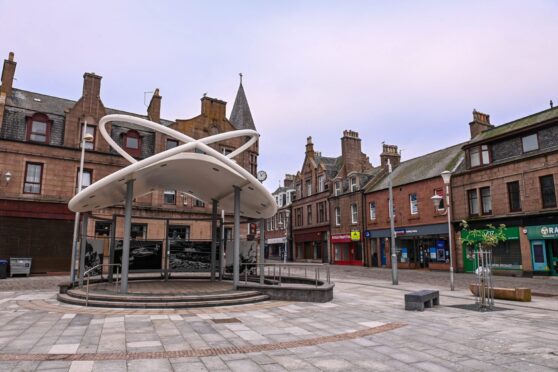The huge sums spent by Aberdeen City Council on removing a potentially life-threatening substance from ageing schools has been revealed in an FOI exclusively obtained by the Press and Journal.
In the last five years, £593,273 has been spent removing potentially harmful asbestos from city schools.
And it is suggested that the figure may be even higher, as a number of projects that include works to remove asbestos, carried out as part of larger refurbishment contracts, were not included in the final totals.
Most recently, works were undertaken to remove asbestos panels from Hazlehead Academy and Bridge of Don Academy, with each leading to safety scares.
Disturbed or damaged asbestos can cause serious disease and even death to those who come into contact with it.
And yesterday union boss Tommy Campbell launched a scathing attack on the city council over safety while he also called for more to be done to remove asbestos from schools and other public buildings.
He said: “There are now no excuses for failing to adopt proper procedures when dealing with this toxic substance.
“The facts are out there.
“That is why it is all the more alarming to find out that asbestos related incidents are still taking place within this community causing risk of exposure to individuals.”
“Council leaders and contractors have a duty of care to their workers and putting them in a situation which could potentially lead to asbestos exposure, knowing the dangers posed, is frankly appalling.
“Penalties must be severe on those that place workers and the public at risk.”
The FOI results obtained by the Press and Journal state that: “Listed are the majority of asbestos removal works that have taken place in schools in the last five years.
“However, there have been a number of projects that include works to remove asbestos, carried out as part of larger refurbishment contracts.
“These works were minor in nature and were a very small part of a larger project.”
In 2016, more than £193,000 was spent on projects to remove asbestos from city schools.
And in 2018 to date, a further £115,583 has been invested in specialist removal of the once popular business material.
In August, the substance was discovered at Hazlehead Academy and removed, the council accepts, “without agreement on safe working practices”.
The substance was found when corrugated cement panels were removed by a sub-contractor during window replacement as the 1970’s building was freshened-up in anticipation of the new school year.
Just weeks before, it was revealed that 25 staff continued to work on repairs at Bridge of Don Academy despite asbestos being found and crudely disposed-of in a nearby skip.
A council investigation revealed there was no emergency response as a line manager “forgot” about the incident for five days.
The redacted report said procedures failed before and after the asbestos insulation board incident.
It detailed how, on July 12, a worker was using a hammer and chisel to remove plasterboard facing and infill panelling above fire doors.
Concern was raised about the material being removed and, after it was decided it could contain asbestos, it was double-bagged and left beside a skip.
It was not until July 17 that the required emergency procedures were initiated for the first time.
A site clean-up was initiated and two vehicles that were used were then quarantined for deep-cleaning.
On 19 July, results from samples confirmed the presence of brown asbestos in the insulating board.
In the days following the incident, teachers, janitors, cleaners and other workers were all revealed to have been on the school’s premises, at risk of being exposed to asbestos.
Responding to the £593,273 spent on removing asbestos in the last five years, SNP councillor Alex Nicoll stressed that safety was of the utmost concern.
He said: “Removing asbestos is an expensive process and this is definitely not an area where we, as a council, should be trying to do anything on the cheap as the safety of our staff and pupils is paramount.”
An Aberdeen City Council spokeswoman said of the spending and the union criticism: “The health, safety and wellbeing of our staff is a priority and we work closely with trade unions to ensure high standards are maintained.
“We value our relationship with all the trade unions.”
Taking action
A warning has been issued that “something needs to be done” before asbestos severely affects a new generation.
At a meeting held yesterday by national charity Asbestos Action, the increase in illnesses caused by the toxic substance was starkly highlighted.
The organisation, which supports people impacted by asbestos, said the boost to mainland construction from work in the North Sea had also exposed workers to the deadly substance.
From June to October, it was revealed there have been 11 new cases reported to the charity, which supports all those affected by asbestos exposure.
The new cases came from a variety of locations across the north-east, including Aberdeen, Macduff, Stonehaven, Ellon and Keith.
Asbestos Action also recorded an increase in the number of people diagnosed with mesothelioma, a type of cancer that develops in the lining of some of the body’s organs, and can spread rapidly.










